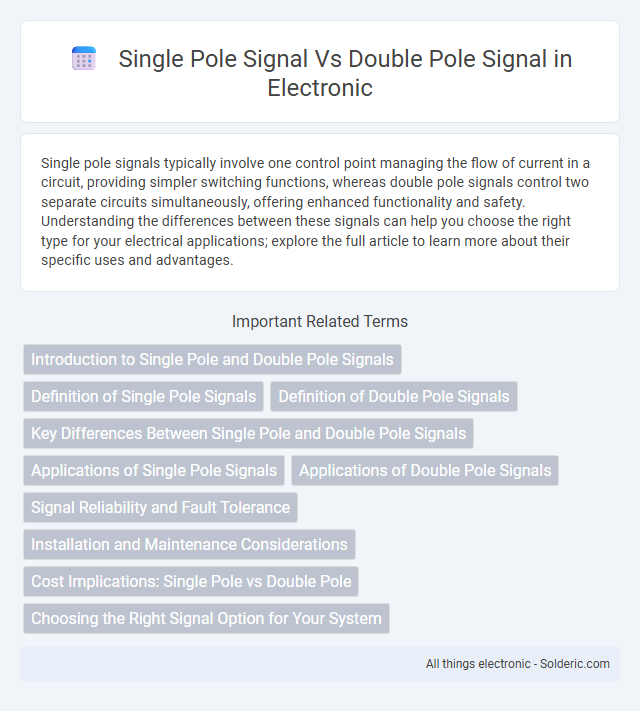Single pole signals typically involve one control point managing the flow of current in a circuit, providing simpler switching functions, whereas double pole signals control two separate circuits simultaneously, offering enhanced functionality and safety. Understanding the differences between these signals can help you choose the right type for your electrical applications; explore the full article to learn more about their specific uses and advantages.
Comparison Table
| Feature | Single Pole Signal | Double Pole Signal |
|---|---|---|
| Definition | Controls one circuit with one input | Controls two circuits simultaneously with one input |
| Number of Poles | One pole | Two poles |
| Signal Channels | Single channel | Dual channel |
| Application | Simple circuit switching | Complex switching or isolating two circuits |
| Cost | Lower cost | Higher cost |
| Switching Capability | Single circuit switching | Simultaneous switching of two circuits |
Introduction to Single Pole and Double Pole Signals
Single pole signals refer to electrical signals controlled by a single switching path, often used in simple on/off applications such as single-pole single-throw (SPST) switches. Double pole signals involve two independent switching paths or circuits that operate simultaneously, commonly found in double-pole double-throw (DPDT) switches enabling control over two separate circuits with one mechanism. Understanding the distinction between single pole and double pole signals is crucial for selecting appropriate switches in electronic and electrical circuit designs.
Definition of Single Pole Signals
Single pole signals refer to electrical signals controlled by a single switching element or contact in a circuit, allowing only one current path to be connected or disconnected at a time. These signals are commonly used in simpler electronic systems where control over a single signal line is required for switching purposes. Understanding the definition of single pole signals helps You optimize circuit design for applications such as basic on/off control, signal routing, and straightforward switching tasks.
Definition of Double Pole Signals
Double pole signals consist of two separate switching poles controlled by a single actuator, allowing one switch to open or close two independent circuits simultaneously. This configuration doubles the control capability compared to single pole signals, which only manage one circuit. You can use double pole signals to enhance electrical isolation and manage more complex wiring systems efficiently.
Key Differences Between Single Pole and Double Pole Signals
Single pole signals control one circuit with a single set of contacts, while double pole signals manage two separate circuits simultaneously using two sets of contacts. Single pole signals are often found in simpler electrical systems where only one connection needs switching, whereas double pole signals provide enhanced control and safety by isolating two circuits in complex systems. Your choice depends on whether single or dual circuit control is required to optimize functionality and security in the electrical design.
Applications of Single Pole Signals
Single pole signals are widely used in applications requiring simple on/off control, such as household light switches, relay circuits, and basic sensor interfaces. Their straightforward design enables reliable operation in low-voltage and low-current environments, making them ideal for controlling individual devices without complex wiring. You can optimize system efficiency by utilizing single pole signals in scenarios where a single circuit path needs to be opened or closed to execute basic control functions.
Applications of Double Pole Signals
Double pole signals are extensively used in applications requiring simultaneous control of two separate circuits with a single switch, such as in complex audio systems, industrial machinery, and double-pole double-throw (DPDT) relay configurations. Your systems benefit from enhanced safety and reliability by isolating and managing multiple electrical paths independently, reducing the risk of short circuits and enabling efficient switching. These signals are crucial in scenarios demanding precise load management and isolation, including HVAC controls and advanced lighting systems.
Signal Reliability and Fault Tolerance
Single pole signals typically offer lower signal reliability due to their dependence on a single path, making them more susceptible to faults and interruptions. Double pole signals enhance fault tolerance by providing two independent pathways, ensuring continuous operation even if one path fails. Your system benefits from improved signal stability and reduced downtime with double pole configurations, especially in critical applications.
Installation and Maintenance Considerations
Single pole signals require simpler wiring with fewer terminals, making installation faster and reducing the risk of wiring errors. Double pole signals offer greater control and safety by isolating two separate circuits, but they demand more complex wiring and careful maintenance to ensure both poles function correctly. Regular inspection of contact points in double pole signals is essential to prevent failures, whereas single pole signals typically have lower maintenance needs due to their simpler design.
Cost Implications: Single Pole vs Double Pole
Single pole signals generally incur lower costs due to simpler design, fewer materials, and easier installation, making them suitable for basic signaling needs. Double pole signals, while more expensive due to added complexity and enhanced functionality, offer greater reliability and versatility in controlling multiple circuits simultaneously. Choosing between single pole and double pole signals depends on budget constraints and the required level of control precision in the application.
Choosing the Right Signal Option for Your System
Selecting the right signal option between single pole and double pole configurations depends on system requirements such as load capacity, voltage handling, and switching precision. Single pole signals are ideal for simpler circuits with lower current demands, providing straightforward control and cost-effectiveness. Double pole signals, by contrast, offer enhanced reliability and safety by managing two separate circuits simultaneously, making them suitable for complex or high-power systems.
single pole signal vs double pole signal Infographic

 solderic.com
solderic.com